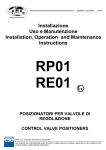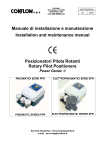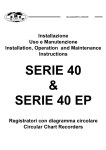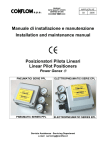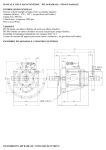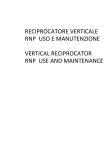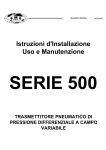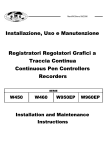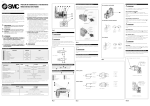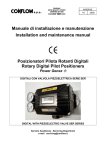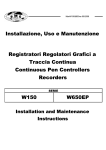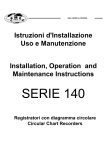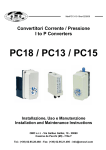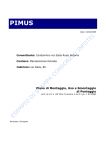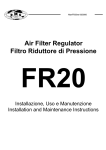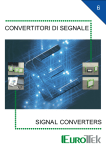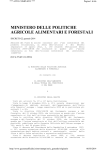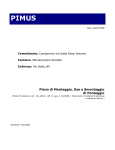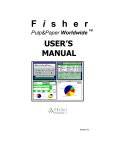Download R99P R99E PVP11BE.1 ATEX
Transcript
ManR99ne 06/2009 www.omcsrl.com Installazione Uso e Manutenzione Installation, Operation and Maintenance Instructions R99P R99E PVP11BE.1 ATEX POSIZIONATORI PER SERVOMOTORI ROTANTI ROTARY VALVE POSITIONERS OMC s.r.l. Industrial Automation Equipment Our products are manufactured under ISO-9001 Quality Assurance System, approved by CSQ certified under nr.9190.OMC2 - FIRST ISSUE 1994/08/04 INDICE INDEX 1. DESCRIZIONE 1. DESCRIPTION 2. DATI TECNICI 2. TECHNICAL DATA 2.1 MATERIALI 2.1 MATERIALS 2.2 PORTATA ARIA 2.3 CONSUMO D'ARIA 2.2 AIR DELIVERY 2.3 AIR CONSUMPTION 2.4 DIMENSIONI DI INGOMBRO 2.4 DIMENSIONS 3. INSTALLATION 3. INSTALLAZIONE 3.1 MONTAGGIO SULL'ATTUATORE 4. COORDINAMENTO TRA ATTUATUATORE E POSIZIONATORE 3.1 FITTING TO THE ACTUATOR 4. CORDINATION BETWEEN POSITIONER AND ACTUATOR 4.1 ATTUATORI A DOPPIO EFFETTO 4.1 DOUBLE ACTING ACUATORS 4.2 ATTUATORI A SEMPLICE EFFETTO 4.2 SINGLE ACTING ACTUATORS 5. CONNESSIONI ELETTRICHE E PNEUMATICHE 5. AIR AND ELECTRICAL CONNECTIONS 6. MONTAGGIO ACCESSORI 6. ACCESSORIES 7. MESSA IN FUNZIONE 7. COMMISSIONING 8. FUNZIONAMENTO IN SPLIT RANGE 8. SPLIT RANGE OPERATION 9. REGOLAZIONE VELOCITÀ VALVOLA 9.VALVE SPEED ADJUSTMENT 10. INVERSIONE DEL SENSO DI ROTAZIONE 10. REVERSING OF ROTATION 11. RICAMBI 11. SPARE PARTS 11.1 R99E e PVP11BE.1 11.2 R99P 11.1 R99E & PVP11BE.1 11.2 R99P 12. MANUTENZIONE 12. MAINTENANCE 13. MALFUNZIONAMENTO: SINTOMI, CAUSE E RIMEDI 13. TROUBLE CHART: SYMPTOMS, CAUSES AND ACTION TO TAKE In caso di problemi di installazione o di funzionamento, contattare il nostro Agente locale o il Servizio di Assistenza Tecnica OMC s.r.l. In case of problems with the installation or operation of this equipment please contact our Local Agent or our Service Department. OMC s.r.l. - Via Galileo Galilei, 18 - 20060 Cassina de Pecchi (MI) - ITALY Tel.: (+39) 02.95.28.468 - Fax: (+39) 02.95.21.495 - [email protected] Pag.2 1. DESCRIZIONE 1. DESCRIPTION Posizionatore a semplice e doppio effetto con segnale in entrata 4÷20mA (R99E) o 3÷15 psi (R99P) per l'azionamento proporzionale di cilindri rotanti. L'apparecchio opera secondo il principio di equilibrio delle forze. Confronta il segnale standard di un regolatore elettronico o pneumatico con l'angolo di rotazione dello stelo inviando un segnale amplificato che agisce sulle camere dell'attuatore. Disponibili anche nella versione a sicurezza intrinseca (Ex ia IIC T6, T5 - ATEX - 94/9/CE- : II 1 G) mod. PVP11BE.1. Single & double-acting Positioner, input signal 4÷20mA (R99E) or 0.2÷1bar (R99P) for proportional control of rotary actuators. The positioner operates on the force-balance principle by comparing the standard signal transmitted from a pneumatic or an electronic controller device and the angular rotation of the stem, and conveys a positioning amplified pressure to the valve actuator. An intrinsically safe version (Ex ia IIC T6, T5 - ATEX - 94/9/CE- : II 1 G), PVP11BE.1 is also available. 2. DATI TECNICI 2. TECHNICAL DATA MONTAGGIO Su staffa ISO 0÷20° (*) 0÷60° (standard) 0÷90° (standard) 0÷180° (*) 0÷270° (*) 0÷360° (*) altre camme (*) CAMMA (Azione diretta o inversa) CONNESSIONI PNEUMATICHE 1/4" NPT ARIA DI ALIMENTAZIONE 0...100 % della pressione di alimentazione USCITA RIPETIBILITA' 3…10 bar R99P < 0,1 % del campo R99E - PVP11BE.1 < 0,2 % del campo R99P < 0,6 % del campo ISTERESI R99E - PVP11BE.1 R99P LINEARITA' R99E - PVP11BE.1 PESO CON MANOMETRI < 2 % del campo IP55 PNEUMATIC CONNECTIONS REPEATIBILITY R99P < 0,1 % of full range R99E - PVP11BE.1 < 0.2 % of full range R99P < 0,6 % of full range HYSTERESIS R99E - PVP11BE.1 R99P NON LINEARITY R99E - PVP11BE.1 PROTECTION CLASS (acc. to EN 60529) < 2 % of full range IP55 -20....+80 °C R99E - PVP11BE.1 -20....+70 °C AMBIENT TEMPERTURE -30....+80 °C STORAGE TEMPERATURE 3÷15 Psi (0,2÷1 bar) altri segnali (*) < 1 % of full range < 1,7 % of full range R99P SEGNALE DI COMANDO 3…10 bar 0...100 % of the supply air pressure OUTPUT WEIGHT WITH GAUGES R99P 1/4" NPT SUPPLY AIR PRESSURE ≅2,4 Kg TEMPERATURA DI STOCCAGGIO 0÷20° (*) 0÷60° (standard) 0÷90° (standard) 0÷180° (*) 0÷270° (*) 0÷360° (*) other cam (*) CAM (Direct and reverse action) < 1,7 % del campo GRADO DI PROTEZIONE EN 60529 TEMPERATURA AMBIENTE < 1 % del campo ISO reccomended mounting bracket MOUNTING ≅2,4 Kg R99P -20....+80 °C R99E - PVP11BE.1 -20....+70 °C -30....+80 °C 3÷15 Psi (0,2÷1 bar) other input (*) R99P INPUT R99E - PVP11BE.1 CONNESSIONI ELETTRICHE (R99E e PVP11BE.1) 4 ÷ 20 mA altri segnali (*) Pressacavo PG9 altre misure (*) ≤ 30 V Ui R99E - PVP11BE.1 ELECTRIC CONNECTIONS (R99E and PVP11BE.1) 4 ÷ 20 mA other input(*) Cable gland PG9 other connections (*) ≤ 30 V Ui Ii ≤ 150 mA Ii ≤ 150 mA Pi ≤ 0,80 W Pi ≤ 0,80 W Max 250 Ω Impedenza Max 250 Ω Impedance Ci ≈ 0 (trascurabile) Ci ≈ 0 (negligible) Li ≈ 0 (trascurabile) Li ≈ 0 (negligible) (*) su richiesta (*) on request Pag. 3 2.1 MATERIALI 2.1 MATERIALS Policarbonato RP01 / RE01 COPERCHIO In alluminio pressofuso verniciatura antiacido PVP11BE.1 In alluminio pressofuso verniciatura antiacido Policarbonato Lega di zinco (ZAMA) CORPO INDICATORE DI POSIZIONE LEVE CAMMA Acciaio INOX Cassetto: Lega di Bronzo Perno: Acciaio INOX CASSETTO DISTRIBUTORE MEMBRANA RICEVITORE Gomma nitrilica Polycarbonate R99P / R99E COVER Die cast aluminium with anti corrosive paint PVP11BE.1 Die cast aluminium with anti corrosive paint Polycarbonate Zamak BODY POSITION INDICATOR LEVERS CAM Stainless Steel Box: Copper Alloy Pivot: Stainless Steel SLIDE VALVE RECEIVER DIAPHRAGM Nitrile Rubber 2.2 PORTATA ARIA 2.2 AIR DELIVERY Prova effettuata con tubo 6 x 8 mm ALIMENTAZIONE 4 BAR regolabile da 1 a 16 Nm³/h ALIMENTAZIONE 6 BAR regolabile da 1 a 22 Nm³/h ALIMENTAZIONE 8 BAR regolabile da 1 a 28 Nm³/h ALIMENTAZIONE 10 BAR regolabile da 1 a 34 Nm³/h Test effected with pipe 6 x 8 mm 4 BAR SUPPLY adjustable from 1 to 16 Nm³/h 6 BAR SUPPLY adjustable from 1 to 22 Nm³/h 8 BAR SUPPLY adjustable from 1 to 28 Nm³/h 10 BAR SUPPLY adjustable from 1 to 34 Nm³/h 2.3 CONSUMO D'ARIA 2.3 AIR CONSUMPTION Prova effettuata con tubo 6 x 8 mm ALIMENTAZIONE 4 BAR ALIMENTAZIONE 6 BAR ALIMENTAZIONE 8 BAR ALIMENTAZIONE 10 BAR 2.4 DIMENSIONI DI INGOMBRO max 0,4 Nm³/h max 0,8 Nm³/h max 1,0 Nm³/h max 1,5 Nm³/h Test effected with pipe 6 x 8 mm 4 BAR SUPPLY 6 BAR SUPPLY 8 BAR SUPPLY 10 BAR SUPPLY max 0,4 Nm³/h max 0,8 Nm³/h max 1,0 Nm³/h max 1,5 Nm³/h 2.4 DIMENSIONS 156 OUTPUT 117 SUPPLY 88 OUTPUT 134 135 SEGNALE DI COMANDO 3 ÷ 15 PSI 3 ÷ 15 PSI INPUT SIGNAL Fig. 2.4 134 Pag. 4 3. INSTALLAZIONE 3. INSTALLATION 3.1 MONTAGGIO SULL'ATTUATORE 3.1 FITTING TO THE ACTUATOR I posizionatori OMC sono dotati di staffa universale che permette il montaggio su qualsiasi attuatore a norme NAMUR semplicemente cambiando la posizione delle viti di fissaggio (vedi Tab. 3.1.3 pagina seguente). The positioners are equipped of universal bracket wich allows to fit the unit of any actuator in according to NAMUR standards, easily changing the position of fixing screws (see Tab. 3.1.3 on next page). 1. Avvitare il perno di centratura del posizionatore nel 1. Place the positioner pivot in the actuator pivot (see perno dell'attuatore (Fig.3.1.1). Fig.3.1.1). 2. Montare la staffa di fissaggio, utilizzando le 4 viti M4. 2. Fit together the four "L" brackets adaptable by means (vedi Tab. 3.1.3 pagina seguente). screws M4 (see Tab. 3.1.3 on next page). 3. Fissare la staffa all'attuatore tramite le 4 viti M5. 3. Screw down the mounting bracket to the actuator by the locking screws M5 as per Fig. 3.1.1 4. Verificare il senso di rotazione dell'attuatore (Capitolo 4) 4. Verify the sense of rotation of the actuator (chapter 4) 5. Montare il posizionatore alla staffa seguendo la Fig. 5. Fit the positioner on the bracket (see Fig.3.1.2). 3.1.2 PERNO DI CENTRATURA PIVOT'S CENTERING Fig. 3.1.1 Fig. 3.1.2 ATTUATORE ACTUATOR Pag. 5 TAB 3.1.3 B A A B POSIZIONI VITI DI FISSAGGIO - "L" BRACKETS MOUNTING R99 20 mm 80 mm ATTUATORE - ACTUATOR R99 30 mm 80 mm ATTUATORE - ACTUATOR R99 30 mm 130 mm ATTUATORE - ACTUATOR R99 50 mm 130 mm ATTUATORE - ACTUATOR Pag. 6 4. COORDINAMETO TRA ATTUATORE E POSIZIONATORE 4. CORDINATION BETWEEN POSITIONER AND ACTUATOR 4.1 ATTUATORI A DOPPIO EFFETTO 4.2 DOUBLE ACTING ACTUATORS Verificare il senso di rotazione dell'attuatore immettendo pressione nelle porte "P1" e "P2" dello stesso. Collegare le uscite del posizionatore "OUT1" e "OUT2" alle porte dell' attuatore secondo la rotazione voluta. (vedi Fig. 4.1.1 e Fig. 4.1.2). Il posizionatore viene fornito per la rotazione in senso antiorario. Per invertire il senso di rotazione è sufficente seguire la procedura a pagina 10. Check the rotation of actuator sending pressure to the inputs "P1" & "P2". Connect the positioner outputs "OUT1" & "OUT2" to the actuator inputs according to the desired rotation. (See Fig. 4.1.1 & Fig. 4.1.2). The positioner is provided with anti-clockwise rotation. To reverse the direction of rotation see page 10. Posizionatore con rotazione antioraria: il segnale in ingresso cresce, l'attuatore ruota in senso antiorario. Anticlockwise rotation of the actuator - Increasing input signal. P1 OUT 1 P2 OUT 2 Fig. 4.1.1 ROTAZIONE ANTIORARIA - ANTICLOCKWISE ROTATION Posizionatore con rotazione oraria: il segnale in ingresso cresce, l'attuatore ruota in senso orario. Clockwise rotation of the actuator - Increasing input signal. P1 OUT 1 P2 OUT 2 Fig. 4.1.2 ROTAZIONE ORARIA - CLOCKWISE ROTATION Pag. 7 4.2 ATTUATORI A SEMPLICE EFFETTO 4.2 SINGLE ACTING ACTUATORS Immettere pressione in una delle due porte dell'attuatore verificandone lo spostamento. Collegare l'uscita "OUT1" del posizionatore con la porta dell'attuatore che ha provocato lo spostamento dello stesso (porta "P1"). Al fine di sfruttare al meglio le caratteristiche del posizionatore, si raccomanda di collegare sempre la restante porta (P2) con l'uscita (OUT2) del posizionatore. Nel momento in cui viene a mancare l'aria di alimentazione, immediatamente intervengono le molle che con la loro azione permettono lo spostamento dell'attuatore e lo scaricamento dell'aria attraverso il posizionatore (vedi Fig. 4.2.1 e Fig. 4.2.2). Send a pressure to one of two inputs to check the actuator rotation ( OUT1). Connect positioner "OUT1" with actuator input ("P1"). For a proper use of positioner, we recommend to connect always the remaining input "P2" with positioner Output ("OUT2"). When the air supply is lacking, the internal springs take action immediately, the actuator moves quickly and the air exhaust flows through the positioner relay. (See Fig. 4.2.1 & Fig. 4.2.2). Posizionatore con rotazione antioraria: il segnale in ingresso cresce, l'attuatore ruota in senso antiorario. Anticlockwise rotation of the actuator - Increasing input signal. P1 OUT 1 P2 OUT 2 Fig. 4.2.1 ROTAZIONE ANTIORARIA - ANTICLOCKWISE ROTATION Posizionatore con rotazione oraria: il segnale in ingresso cresce, l'attuatore ruota in senso orario. Clockwise rotation of the actuator - Increasing input signal. P1 OUT 1 P2 OUT 2 Fig. 4.2.2 ROTAZIONE ORARIA - CLOCKWISE ROTATION Pag. 8 5. CONNESSIONI PNEUMATICHE E 5. AIR AND ELECTRICAL CONNECTIONS Tutti i collegamenti pneumatici sono facilmente accessibili (vedi Fig. 2.4). Per le connessioni elettriche (R99E e PVP11BE.1) inserire i due fili nel passacavo e collegarli alla morsettiera interna contrassegnata con "+" e "-". Per assicurare il corretto funzionamento del Posizionatore, l'aria di alimentazione deve essere libera da ogni impurità quali polveri, ecc. utilizzando un filtro riduttore installato in linea. All pneumatic connections are easily accessible externally (see Fig. 2.4) To ensure trouble free use of this positioner, the air supply should be conditioned to remove dirt and moisture. A filter regulator should be fitted upstream of the device. Electrical connections are made by moving the lid. ATTENZIONE! CAUTION! I posizionatori modello PVP11BE.1 (sicurezza intrinseca) devono essere alimentati da costruzioni elettriche associate certificate in conformità alle norme EN 60079 che rispettino i limiti delle caratteristiche elettriche indicate nel paragrafo 2. 6. MONTAGGIO ACCESSORI The positioners type PVP11BE.1 (intrinsic safety) must be feed by electric devices certificated in conformity with EN 60079 standards. The devices must comply the electric features mentioned on technical specification (see chapter 2). 6. ACCESSORIES CASSETTA CON FINECORSA TRASMETTITORE DI POSIZIONE 4÷20mA LIMIT SWITCHES BOX 4...20 mA POSITION TRANSMITTER VPI3D Kit INDICATORE DI POSIZIONE TRIDIMENSIONALE TRIDIMENSIONAL POSITION INDICATOR PTL7 Kit Fig. 6 VPI3D Kit + R99 PTL7 Kit + R99 VPI3D Kit + PTL7 Kit + R99 Pag. 9 7. MESSA IN FUNZIONE 7. COMMISSIONING 1. Controllare che tutti i collegamenti siano corretti. 2. Alimentare il posizionatore. 1. Check the piping connections 2. Feed the positioner. N.B. Il posizionatore viene fornito per la rotazione in Note: The positioner is suplied with clockwise rotation senso antiorario. Per invertire il senso di rotazione è as standard. To reverse the way of rotation follows the sufficente seguire la procedura descritta al paragrafo procedure on item 10. 10. 3. Send a 3 psi or 4mA signal to the positioner 3. Inviare un segnale di 3 psi o 4 mA al posizionatore e reaching the actuator starting point, by shifting the zero agire sulla vite di zero (Fig. 7) sino a far partire la adjustment screw (Fig.7) valvola. 4. Turn slightly the screw (Fig. 7) to the opposite 4. Girare la vite di zero, molto lentamente, in senso direction until the actuator is come back to the starting contrario sino a portare la valvola in posizione di inizio position. corsa. 5. Send a 15 psi or 20mA signal to the positioner and 5. Inviare un segnale di 15 psi o 20 mA al posizionatore check the valve opening. e verificare l'apertura della valvola. 6. In case of the valve stroke is still incorrect, then 6. Se la corsa della valvola non corrisponde a quella release the screw nut "1" and turn the span desiderata, allentare il dado "1" e agire sulla vite adjustment screw (Fig. 7). Turn that screw on di correzione campo. Ruotare la vite in senso orario per clockwise direction to increase the span or aumentare il campo e in senso opposto per diminuirlo. anticlockwise to reduce it. During the operation mind Durante questa operazione tenere presente che ogni that any complete turn of screw means about 2° of rotazione completa della vite, corrisponde a circa 2° di valve rotation angle. Now lock the nut "1". rotazione della valvola. Serrare il dado "1". 7. Repeat the zero adjustment still sending a 3 psi or 7. Inviare un segnale di 3 psi o 4 mA al posizionatore e 4mA signal to the positioner. ripetere la correzione di zero. 8. Send again a 15 psi or 20mA signal to the positioner 8. Inviare un segnale di 15 psi o 20 mA al posizionatore and check the valve opening. e verificare l'apertura della valvola. Se necessario If necessary, repeat the operation of items 6 and7 until ripetere le operazioni da 6 a 7 sino al conseguimento the right calibration is reached. dei valori desiderati. CORREZIONE ZERO ZERO ADJUSTMENT Fig. 7 (R99E) CONNESSIONI ELETTRICHE 4÷20mA ELECTRICAL CONNECTIONS 4÷20mA 1 A CORREZIONE CAMPO B Pag. 10 8. FUNZIONAMENTO IN SPLIT RANGE 8. SPLIT RANGE OPERATION Parecchie applicazioni richiedono che la valvola esegua i 90° di corsa con il segnale in ingresso ridotto del 50% (3÷9psi o 9÷15psi per R99P ; 4÷12mA o 12÷20mA per R99E). Nel caso sia richiesta questa operazione è sufficiente allentare il dado "1" Fig. 7, far compiere alla vite di regolazione campo circa 22 giri completi in senso orario e ripetere la procedura del capitolo precedente sostituendo i segnali in ingresso. Many applications require the 90° of valve stroke with a 50% reduced input signal (3÷9 psi or 9÷1 5 for R99P; 4÷12 or 12÷20 mA for R99E). In this case release the screw nut "1" (Fig. 7) and turn the span adjustment of about 22 periods on clockwise direction and repeat the procedure of the previous chapter (by using the suitable input signals). 9. REGOLAZIONE VELOCITÀ VALVOLA 9. VALVE SPEED ADJUSTMENT Con i posizionatori R99 è possibile regolare separatamente le velocità di apertura e chiusura della valvola, agendo sulle viti "A" e"B" Fig.7. Per diminuire le velocità, allentare i dadi di bloccaggio e ruotare le viti in senso orario. Per aumentare le velocità, allentare i dadi di bloccaggio e ruotare le viti in senso antiorario. La massima velocità si ottiene A splitted opening / closing speed adjustment of the valve should be made by means the nut screws "A" & "B" (Fig.7). To rise the valve speed, release these nuts and turn the screw on anticlockwise direction. The maximum speed is obtained by removing the nut screws "A" & "B" completely. togliendo del tutto le viti "A" e"B" 10. INVERSIONE DEL SENSO DI ROTAZIONE ATTENZIONE! Prima di compiere questa manovra, assicurarsi che il posizionatore non sia alimentato. Il posizionatore viene fornito per la rotazione in senso antiorario (Fig.10.1). Per invertire il senso di rotazione è sufficente seguire la procedura sotto: 1) Allentare il dado blocca camma "C" 2) Ruotare la camma in senso orario, portando il cuscinetto "D" all'incirca nella posizione in Fig.10.2 3) Serrare il dado "C". 4) Ripetere la procedura del capitolo 7 Fig. 10.1 10. ROTATION REVERSING CAUTION! Before be over this operate, make sure that the positioner has not in pressure. The positioner is provided with anti-clockwise rotation (see fig. 10.1). To reverse the direction of rotation see the following items: 1) Release the nut "C" 2) Rotate the cam wheel as the arrow on Fig.10.2 (clockwise rotation). Hold the bearing on "D" position. 3) Lock the nut "C". 4) Now repeat the procedure mentioned on chapter 7. Fig. 10.2 C D CAMMA CAM Pag. 11 11. RICAMBI 11. SPARE PARTS 11.1 R99E e PVP11BE.1 11.1 R99E & PVP11BE.1 972IPT 072-46 200-25 072-42 200-32 200-41 988SRE 200-30 200-19 988CAE 200-42 110-145 110-164 R99E PVP11BE.1 972GMZ 200-31 200-44 073-105 073-106 972S11 PVP11BE.1 PVP11BE.1 R99E R99E INPUT mA INPUT Volt INPUT mA INPUT Volt 200-16 Pag. 12 11.2 R99P 11.2 R99P 972IPT 072-46 200-25 072-42 200-41 988SRP 200-29 200-19 988CAP 200-42 972GMZ 972S11 200-16 Pag. 13 12. MANUTENZIONE (solo R99E e PVP11BE.1) 12. MAINTENANCE (only R99E and PVP11BE.1) Le impurità contenute nell'aria di alimentazione (olii, polveri, acqua, ecc...), sono la principale causa delle anomalie di funzionamento del posizionatore. Esse si depositano all'interno del posizionatore stesso ostruendone le parti vitali. L'utilizzo di un filtro sull'aria di alimentazione diminuisce, ma non vieta, il formarsi di depositi. Periodicamente occorre quindi rimuovere le eventuali impurità come segue: 1) Chiudere l'alimentazione al posizionatore. 2) Svitare la vite "A" (vedi Fig.12) 3) Estrarre il particolare "B" 4) Pulire il foro calibrato con c'apposito pulitore "C" posto all'interno del coperchio The incoming air impurities (oil, dust, water etc..) are the main cause of positioner failures. These impurities seep into the internal parts of the equipment which get occluded consequently. The use of an air filter upstream reduces the internal sediments but it does not exclude them completely. To avoid any failure caused by the impurities then clean periodically the nozzle as follow: 1) Stop the air feed 2) Unloose the screw "A" (see fig.12) 3) Pull out the nozzle plate "B" 4) Clean the calibrated orifice with the nozzle cleaner "C" which is located on the positioner cover The frequency of such cleaning operation depends on the La periodicità di tali operazioni dipende dalla qualità dell'aria air feed quality. di alimentazione. Fig. 12 B A C 13. MALFUNZIONAMENTO: SINTOMI, CAUSE E RIMEDI 13. TROUBLE: SYMPTOMS, CAUSES AND ACTION TO TAKE Prima di mettere mano allo strumento, verificare quanto Before operating the unit, please check: segue: - the unit proper supply - corretta alimentazione dello strumento - the pneumatic and process connections - collegamenti pneumatici e di processo - the good operating conditions and status of the valve - buon funzionamento e stato della valvola SINTOMO CAUSA RIMEDIO SYMPTOM Velocità di apertura e Diminuire la velocità. chiusura della valvola Vedi capitolo 9 elevata. Mancato collegamento della porta "P2" L'attuatore pendola e dell'attuatore a semplice effetto. non si stabilizza. Errato dimensionamento tra attuatore e valvola; l'attuatore è sottodimensionato. CAUSE ACTION TO TAKE Opening/Closing Reduce the speed. See valve speed too high chapter 9 Connection "P2" Connect the item "P2". missing on the single See chapter 4.2 acting actuator Collegare la porta. Vedi capitolo 4.2 Actuator hunting Utilizzare un attuatore di dimensioni maggiori adatto all'utilizzo del posizionatore. Wrong sizing Use a bigger actuator between actuator suitable to operate with and valve; the the positioner. actuator is undersize. Pag. 14 SINTOMO CAUSA SYMPTOM CAUSE ACTION TO TAKE Velocità di apertura e L'attuatore si muove Aumentare la velocità. chiusura della valvola molto lentamente. Vedi capitolo 9 bassa. Actuator motion is too slow. Opening/Closing valve speed too low Increase the speed. See chapter 9 Velocità di apertura e L'attuatore si muove Diminuire la velocità. chiusura della valvola troppo velocemente. Vedi capitolo 9 elevata. Actuator motion is too high. Opening/Closing Reduce the speed. See valve speed too high chapter 9 Strozzatura ostruita Correggere. da depositi di impurità Vedi capitolo 12 The orifice is obstruct from impurity Connessioni pneumatiche tra posizionatore e attuatore invertite Correggere. Vedi capitolo 4 Pneumatic connection between Reverse its position actuator and See chapter 4 positioner has been inverted Correggere. Vedi capitolo 4 Actuator and Adjust. positioner coupling is See chapter 4 not correct Coordinamento tra Il posizionatore non attuatore e regola correttamente posizionatore errato. apertura e chiusura dell'attuatore. Collegamenti elettrici invertiti. L'attuatore non compie il campo desiderato RIMEDIO Positioner with wrong control action Correggere. Vedi capitolo 5 Reverse its position See chapter 12 Electric connections Adjust. has been inverted. See chapter 5 La camma si trova in Correggere. posizione errata Vedi capitolo 10 The position of cam wheel is wrong Adjust. See chapter 10 Mancanza del Controllare e segnale di comando correggere. Control signal missing Check and adjust Mancanza aria di alimentazione Controllare e correggere. Supply air missing Check and adjust Regolazione di campo errata Correggere. Vedi capitolo 7 Actuator span inadequate Span adjustment is wrong Adjust. See chapter 7 Correggere. Vedi capitolo 7 Actuator start point shifted Zero adjustment missing Adjust. See chapter 7 L'attuatore non parte Regolazione di zero dalla posizione errata desiderata Pag. 15















